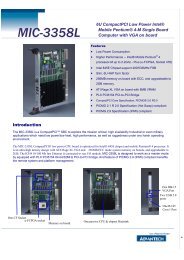industrial wireless book special edition - Networking ...
industrial wireless book special edition - Networking ...
industrial wireless book special edition - Networking ...
You also want an ePaper? Increase the reach of your titles
YUMPU automatically turns print PDFs into web optimized ePapers that Google loves.
With Diversity Path Mesh (left) all data packets propagate across the mesh, and every<br />
node in the mesh, in a single wave. A strict synchronistic mechanism prevents<br />
transmitted packets from echoing around the nodes as unwanted reflections and loops.<br />
The simple propagation concept requires little processing power for routing algorithms<br />
when compared to that required in isolating a standard single routing path.<br />
[One might imagine that every node carrying every data packet would end up using more<br />
battery power overall, but the authors are adamant that this is not the case – Ed]<br />
routing information. Furthermore, there is no set up time and any number<br />
of nodes can be inserted or removed. As long as the added or remaining<br />
nodes are within the reception range, the network simply continues to<br />
operate – without healing time and network downtime.<br />
Until recently, the use of flooding in standard mesh network architectures<br />
has been avoided for several reasons, commonly known as the<br />
‘broadcast storm problem’. Simply put, nodes within reception range<br />
retransmit the message whenever received. This results in an uncontrollable<br />
series of collisions which degrade network performance and<br />
increase energy consumption to unacceptable levels.<br />
To channel the flooding technique into a practical and useful solution,<br />
Diversity Path Mesh makes use of high level synchronisation. Messages at<br />
each node are relayed to the surrounding nodes with precise timing, thus<br />
forming multiple concomitant transmission paths on the way to the destination.<br />
The retransmission of messages through the network is synchronised<br />
to sub-bit level through using TDMA as the master construction framework.<br />
Instead of interfering which each other, the multiple and identical, ±noise,<br />
transmissions received by the node receivers can then be summed together<br />
in a demodulator function block. This summing action increases the strength<br />
(so decreasing the error rate) of the received signal.<br />
Overall, the scheme returns increased reliability since there is no single<br />
point (node) of failure, and increased propagation robustness due to<br />
the inherent spatial diversity of the propagation through the multiple<br />
relay paths. The same summing mechanism which is at the heart of the<br />
proposition translates to greater range. It also virtually eliminates dead<br />
spots in steady state conditions, multipath occurrence, the effects of<br />
RF interference and the effects of changes in propagation paths.<br />
There is a significant reduction in the probability of a message failing<br />
to reach its destination. With sequential propagation from node to node<br />
in a standard mesh network, the time delay adds sequentially with each<br />
propagation step. With simultaneous propagation across the mesh, the<br />
time delay to get from one side to the other is greatly reduced over a<br />
sequential propagation mode. Relaying the messages also enables DPM<br />
networks to extend as far as needed, with the cell overall range and<br />
robustness rising with an increasing number of nodes. The maximum<br />
number of nodes which could be deployed exceeds any practical requirement<br />
for such applications.<br />
In a nutshell, the behaviour of a DPM network has these characteristics:<br />
● The nodes are the network and there are no routers. Once the nodes<br />
are connected and powered, the network is up and running. Also there<br />
is no need for network management and consequently no need to develop<br />
software to manage the network. Compared to router-based networks,<br />
extended software development and field tests are eliminated.<br />
● The operation of adding or removing nodes is immediate and effortless.<br />
There is no such notion as reprogramming or resetting, hence there are<br />
no corresponding delays and no downtime.<br />
● Messages propagate in simultaneous, parallel paths, thus increasing<br />
the range between nodes and improving the resiliency to external<br />
conditions and RF interference.<br />
● The network traffic comprises practically pure data with no<br />
management overhead, resulting in high data throughput and lower<br />
power consumption as a consequence.<br />
● The number of times the data may be retransmitted by relay (the<br />
number of legs or hops) is practically unlimited, with actual numbers<br />
far exceeding the requirements of real applications. For example, with<br />
the basic range between nodes being some 2km (with a high power<br />
module) a coverage area spanning 60km can be easily achieved within<br />
30 hops within a DPM network cell.<br />
● Increasing the number of nodes either increases the size of the<br />
network cell, or the robustness of the network, or both.<br />
Conclusion<br />
Flooding is arguably the most appropriate technique to be considered<br />
for creating a network mesh as it addresses critical performance factors<br />
of <strong>wireless</strong> mesh networks, as well as the accompanying system tradeoffs.<br />
However, the flooding technique carries several grave drawbacks which<br />
have precluded its use in the past.<br />
Diversity Path Mesh is probably the first mesh <strong>wireless</strong> network to use<br />
the flooding technique instead of standard routing; synchronised<br />
flooding produces a surprising performance benefit over and above the<br />
positive benefits of flooding propagation.<br />
Products based on this technology and deployed by its originator,<br />
Virtual Extension, have proven the capability of Diversity Path Mesh,<br />
now successfully deployed in projects where other technologies have<br />
been unable to deliver. These applications include smart metering –<br />
electricity water and gas, smart and emergency lighting, building and<br />
<strong>industrial</strong> automation, vending machines, agriculture and security.<br />
Marius Gafen is involved with Israeli start-up company Virtual Extension Inc<br />
www.virtual-extension.com<br />
First published in the <strong>industrial</strong> ethernet <strong>book</strong> May 2010<br />
Industrial Wireless<br />
sponsored by Advantech<br />
<strong>industrial</strong> ethernet <strong>book</strong><br />
47

















